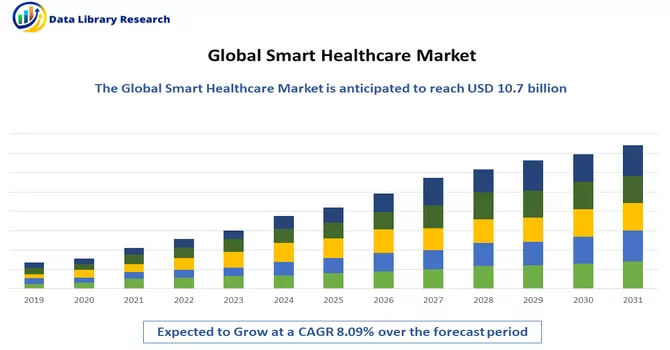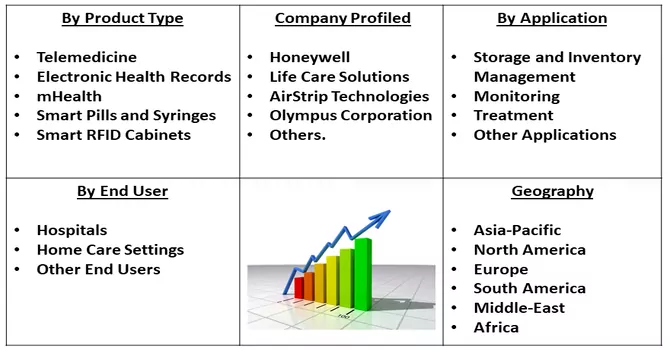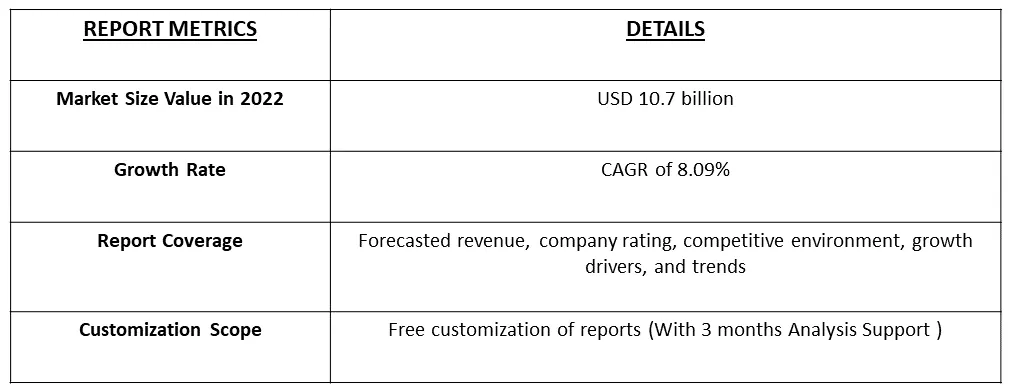The Smart Healthcare Market was currently valued at USD 10.7 billion in the year 2022 and is expected to increase to USD 19.8 billion by the end of 2030, registering a CAGR of 8.09% over the forecast period.

Get Complete Analysis Of The Report - Download Free Sample PDF
Smart healthcare products improve outcomes related to diagnostic tools and enhance patient treatment, along with improving their quality of life. Smart health products come with embedded communication, sensor technologies, and data analytics techniques. These products are used for monitoring individuals physically for diagnosis and ongoing disease treatments.
The rising adoption of mHealth, government initiatives to digitize healthcare, and the prevalence of chronic disorders are likely to accentuate the demand for smart healthcare systems. Digitalization has transformed the healthcare industry. The adoption of mHealth has increased substantially in the past few years, majorly owing to the rising usage of smartphones and digitization.
Emerging technological advancements in smart healthcare products are revolutionizing the healthcare industry. These advancements include several technologies, including the Internet of Things (IoT), artificial intelligence (AI), wearable devices, telemedicine, and remote monitoring systems. All these latest developments are providing the market opportunities for the growth of the studied market.
Segmentation:
The Smart Healthcare Products Market is Segmented
By Product Type :
Application :
End User :
Geography.
The report offers the market size and forecasts in value (USD million) for the above-mentioned segments.

For Detailed Market Segmentation - Download Free Sample PDF
Drivers:
The Prevalence of Chronic Disorders.
The rise of chronic diseases is contributing to the growth of the studied market. For instance, in 2021, CDC reported that around 18.2 million adults aged 20 and older had coronary artery disease (CAD) in the United States. Heart disease is the leading cause of death in the United States. Also, as per the 2022 update from the International Diabetic Federation (IDF), approximately 537 million adults (20-79 years) are living with diabetes. The total number of people living with diabetes is projected to rise to 643 million by 2030 and 783 million by 2045. The high incidence of chronic diseases increases the demand for huge smart healthcare products, which, in turn, drives the market.
The growing adoption of IoT in Smart Healthcare Market.
In healthcare, IoT applications benefit patients, families, physicians, hospitals, and insurance companies. According to the study published in Oral Biology and Craniofacial Research in April 2022, IoT is a developing technology that delivers enhancements and improved solutions in the medical area, such as proper medical record-keeping, sample, device integration, and illness causes. Sensor-based IoT technology has the potential to significantly minimize the risk of surgery in complex circumstances. Thus, such advantages are expected to raise the demand for IoT-based smart healthcare products, thereby boosting the growth of the market.
Restraints:
The High Cost of Smart Healthcare Market Products.
The high cost of smart healthcare products can be attributed to several factors, each of which contributes to the overall expense of these advanced technologies. Smart healthcare products are subject to various regulations and certifications imposed by governmental and health regulatory bodies. Meeting these regulatory requirements necessitates additional testing, documentation, and compliance efforts, which can increase costs.
Moreover, healthcare products, including smart devices, must adhere to stringent quality and safety standards to ensure they are reliable and safe for use by patients. Meeting these standards requires rigorous testing, certifications, and compliance measures, all of which contribute to higher costs. Thus, such factors are expected to slow down the growth of the studied market over the forecast period.
Segmental Analysis:
Smart Healthcare Market Segment is Expected to Witness High Growth Over the Forecast Period.
Smart Healthcare is the remote delivery of healthcare services, such as consultations over telecommunication or teleconference, and it allows healthcare professionals to evaluate, diagnose, and treat patients. Furthermore, such developments are expected to fuel the growth of the studied market. For instance, in August 2022, Hicuity Health launched tele-ICU services at MUSC Health Columbia Medical Center Downtown in Columbia, South Carolina. The new service launch draws upon MUSC Health's long-standing collaboration with Hicuity Health which delivers telemedicine services to hospitals across the state.
Monitoring Devices are expected to Fuel the Growth of the studied Market.
Patient monitoring devices are monitoring devices that continuously monitor the patient’s vital parameters, like blood pressure and heart rate, by using a medical monitor and collecting medical (and other) data from individuals. The launch of new products is expected to fuel the growth of the studied market. For instance, in January 2022, MDLIVE launched patient health monitoring to drive health improvements for people living with chronic conditions. This digital-first program aims to improve health outcomes for people living with chronic health conditions like diabetes, heart disease, or high blood pressure.
North America Holds a Significant Share in the Smart Healthcare Market and May Continue to do the Same during the Forecast Period.
The smart healthcare product market is expected to grow in the North American region due to supportive government policies for the deployment of digital health and the accessibility of infrastructure with high digital literacy. The presence of key market participants, growing awareness about connected healthcare, high penetration of the internet and smartphones, and the usage of health-related apps are a few key factors responsible for the growth of the regional market. According to a study published in Nature Review Cardiology in August 2021, an estimated 20% of US residents currently own a smart wearable device to monitor their health. Thus, with the rising adoption of smart wearable devices in the country, the market is expected to grow over the forecast period.

Get Complete Analysis Of The Report - Download Free Sample PDF
The smart healthcare products market is at a growing stage, and it is moderately competitive. Market players focus on new product launches, such as essential cardiology and blood glucose monitors. Smartwatches, health monitors, pedometers, and activity trackers are smart wearable devices launched by several companies. Companies are focusing on industry collaborations, mergers, acquisitions, and partnerships to enhance their presence in the smart healthcare products market.
Key Players :
Recent Developments:
1) In March 2022, Intuitive MB launched its medical building operating system, which uses the Internet of Things (IoT), artificial intelligence (AI), and machine learning technologies to create "smart" hospitals and medical office buildings.
2) In March 2022, Commonwealth Bank launched a new smart terminal, Smart Health, which helped all major Australian private health insurers improve payments and claim experience.
Q1. What is the current Smart Healthcare Market size?
The Smart Healthcare Market was currently valued at USD 10.7 billion.
Q2. What is the Growth Rate of the Smart Healthcare Market?
Smart Healthcare Market is registering a CAGR of 8.09% over the forecast period.
Q3. What are the Growth Drivers of the Smart Healthcare Market?
The Prevalence of Chronic Disorders and growing adoption of IoT in are the growth drivers of the Smart Healthcare Market.
Q4. Which region has the largest share of the Smart Healthcare Market? What are the largest region's market size and growth rate?
North America was the largest region in the Smart Healthcare Market in 2022. For detailed insights on the largest region's market size and growth rate request a sample here.
Data Library Research are conducted by industry experts who offer insight on industry structure, market segmentations technology assessment and competitive landscape (CL), and penetration, as well as on emerging trends. Their analysis is based on primary interviews (~ 80%) and secondary research (~ 20%) as well as years of professional expertise in their respective industries. Adding to this, by analysing historical trends and current market positions, our analysts predict where the market will be headed for the next five years. Furthermore, the varying trends of segment & categories geographically presented are also studied and the estimated based on the primary & secondary research.
In this particular report from the supply side Data Library Research has conducted primary surveys (interviews) with the key level executives (VP, CEO’s, Marketing Director, Business Development Manager and SOFT) of the companies that active & prominent as well as the midsized organization
FIGURE 1: DLR RESEARH PROCESS

Extensive primary research was conducted to gain a deeper insight of the market and industry performance. The analysis is based on both primary and secondary research as well as years of professional expertise in the respective industries.
In addition to analysing current and historical trends, our analysts predict where the market is headed over the next five years.
It varies by segment for these categories geographically presented in the list of market tables. Speaking about this particular report we have conducted primary surveys (interviews) with the key level executives (VP, CEO’s, Marketing Director, Business Development Manager and many more) of the major players active in the market.
Secondary ResearchSecondary research was mainly used to collect and identify information useful for the extensive, technical, market-oriented, and Friend’s study of the Global Extra Neutral Alcohol. It was also used to obtain key information about major players, market classification and segmentation according to the industry trends, geographical markets, and developments related to the market and technology perspectives. For this study, analysts have gathered information from various credible sources, such as annual reports, sec filings, journals, white papers, SOFT presentations, and company web sites.
Market Size EstimationBoth, top-down and bottom-up approaches were used to estimate and validate the size of the Global market and to estimate the size of various other dependent submarkets in the overall Extra Neutral Alcohol. The key players in the market were identified through secondary research and their market contributions in the respective geographies were determined through primary and secondary research.
Forecast Model
